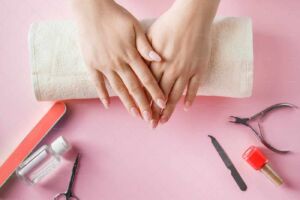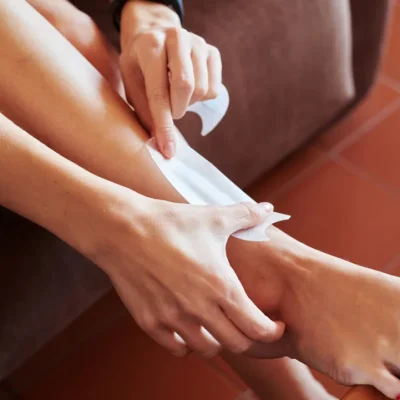Embarking on a journey to restore and maintain healthy nails involves understanding the intricacies of nail care and discovering the best treatments tailored to your needs. In this comprehensive guide, Diva Salon delve into ten essential aspects of nail care for damaged nails, exploring a range of treatments and strategies to promote nail health and resilience. From nail strengtheners fortified with protein and calcium to hydrating nail masks infused with nourishing oils, each treatment plays a vital role in addressing specific nail concerns. We also discuss the importance of avoiding harsh chemicals, regular trimming, and maintenance, as well as seeking professional advice through nail care consultations.
1. Nail Strengtheners: Fortifying Your Nails
Nail strengtheners are a popular choice for individuals looking to fortify their nails and prevent breakage. These treatments often contain key ingredients such as protein, calcium, and vitamins that work together to strengthen the nails and promote overall nail health.
Protein is essential for nail strength, as it helps repair damage and build resilience. Nail strengtheners enriched with proteins like keratin can effectively strengthen weak, brittle nails, reducing the risk of splitting and breakage. Additionally, calcium is crucial for maintaining nail integrity and preventing brittleness. Calcium-infused nail strengtheners can replenish calcium levels in the nails, making them less prone to cracking and peeling.
Vitamins such as vitamin E and vitamin B7 (biotin) are also common ingredients in nail strengtheners. Vitamin E is a potent antioxidant that nourishes and moisturizes the nails, promoting flexibility and preventing dryness. Biotin, on the other hand, plays a vital role in promoting healthy nail growth and reducing brittleness.
When using nail strengtheners, it’s essential to follow the application instructions carefully. Apply a thin, even coat to clean nails and reapply as directed for optimal results. Consistent use of nail strengtheners can lead to stronger, healthier nails over time, making them less susceptible to damage.
2. Cuticle Oils: Nourishing Your Nails and Cuticles
Cuticle oils are a staple in nail care routines, known for their ability to nourish and moisturize both the nails and the surrounding cuticle area. These oils are often formulated with a blend of botanical oils such as jojoba oil, almond oil, and vitamin E oil, all of which offer unique benefits for nail and cuticle health.
Jojoba oil is prized for its similarity to the skin’s natural oils, making it easily absorbed and highly moisturizing. When applied to the nails and cuticles, jojoba oil helps soften dry, rough skin, reducing the risk of hangnails and promoting a healthy nail bed.
Almond oil is rich in vitamins and minerals, including vitamin E and magnesium, which nourish and strengthen the nails. It also has anti-inflammatory properties, making it ideal for soothing irritated cuticles and promoting overall nail health.
Vitamin E oil is a potent antioxidant that protects the nails and cuticles from free radical damage, preventing dryness and promoting elasticity. Regular application of cuticle oils can improve nail flexibility, reduce brittleness, and enhance the overall appearance of the nails.
To use cuticle oils effectively, simply apply a small amount to the nails and massage gently into the cuticle area. Repeat this process regularly, especially after removing nail polish or exposing the nails to harsh environmental conditions, to keep your nails and cuticles well-nourished and hydrated.
3. Nail Growth Serums: Stimulating Healthy Nail Growth
Nail growth serums are designed to stimulate the growth of healthy nails while repairing damage caused by factors such as nail biting or aggressive nail treatments. These serums often contain ingredients that promote nail growth, strengthen the nails, and improve overall nail quality.
One key ingredient commonly found in nail growth serums is peptides. Peptides are amino acid chains that support collagen production, which is essential for maintaining nail strength and structure. By promoting collagen synthesis, peptides in nail growth serums can help repair damage and encourage healthy nail growth.
Another beneficial ingredient in nail growth serums is biotin, also known as vitamin B7. Biotin is a water-soluble vitamin that plays a crucial role in supporting nail health and promoting faster nail growth. Regular use of biotin-infused nail growth serums can lead to stronger, longer nails with improved resilience.
Additionally, some nail growth serums may contain botanical extracts such as ginseng or horsetail extract, which are rich in vitamins and minerals that nourish the nails and promote optimal nail growth conditions.
To use nail growth serums effectively, apply a small amount to clean, dry nails and massage gently into the nail bed and cuticle area. Follow the product instructions for frequency of application, and be consistent to achieve the best results in terms of nail growth and overall nail health.
4. Keratin Treatments: Strengthening and Protecting Nails
Keratin treatments are specifically formulated to strengthen and protect nails, particularly those that are weak, brittle, or prone to splitting and peeling. Keratin is a fibrous protein that forms the structural foundation of nails, hair, and skin, making it an excellent ingredient for enhancing nail strength and resilience.
In keratin treatments for nails, hydrolyzed keratin is often used. Hydrolyzed keratin is a form of keratin that has been broken down into smaller molecules, allowing for better absorption into the nails and cuticles. When applied topically, hydrolyzed keratin can penetrate the nail structure, filling in gaps and reinforcing weak areas.
Keratin treatments not only strengthen the nails but also provide a protective barrier against external damage. This can be especially beneficial for individuals who frequently expose their nails to water, chemicals, or mechanical stressors, as keratin helps minimize the risk of nail breakage and damage.
To use keratin treatments effectively, follow the product instructions for application. Typically, you’ll apply the treatment to clean, dry nails and allow it to absorb fully before applying nail polish or engaging in activities that may compromise nail integrity. Regular use of keratin treatments can lead to visibly stronger, healthier nails over time.
5. Gelatin Supplements: Boosting Nail Strength from Within
Gelatin supplements are often recommended for individuals looking to boost nail strength and promote healthy nail growth from within. Gelatin is a protein derived from collagen, the primary structural protein in nails, hair, and skin. Consuming gelatin supplements provides the body with the building blocks it needs to support nail health and integrity.
One of the key benefits of gelatin supplements is their ability to improve nail strength and reduce brittleness. Gelatin contains amino acids like glycine, proline, and hydroxyproline, which are essential for collagen synthesis and the formation of strong, resilient nails.
Additionally, gelatin supplements may promote faster nail growth, allowing individuals to achieve longer nails more quickly. This can be particularly advantageous for those who struggle with slow nail growth or who are looking to recover from nail damage more rapidly.
When taking gelatin supplements for nail health, it’s important to choose high-quality products and follow the recommended dosage instructions. Results may vary depending on individual factors such as diet, overall health, and the severity of nail damage. Consistency is key, so continue taking gelatin supplements as directed to support ongoing nail strength and growth.
Incorporating these various nail treatments into your routine can help address different aspects of nail damage and promote overall nail health and vitality. Whether you’re dealing with weak, brittle nails, slow nail growth, or other nail concerns, there are effective solutions available to support your nail care journey. Experiment with different treatments, listen to your nails’ needs, and enjoy the benefits of stronger, healthier nails over time.
Avoiding harsh chemicals is crucial for maintaining nail health and preventing further damage. Many nail products, such as nail polish removers, acrylic nails, and certain nail treatments, contain chemicals that can weaken the nails and cause dryness and brittleness over time.
One of the most common harsh chemicals to avoid is acetone, a potent solvent often found in nail polish removers. While acetone effectively removes nail polish, frequent use can strip the nails of their natural oils, leading to dryness and weakening of the nail structure. Opt for acetone-free nail polish removers or gentle formulas that are less likely to cause damage.
Similarly, acrylic nails and nail extensions can be harsh on natural nails if not applied or removed properly. The adhesives used to attach acrylic nails can weaken the nail bed, while improper removal techniques can lead to nail damage and breakage. If you choose to wear acrylic nails, ensure they are applied by a skilled technician using quality products, and follow proper removal procedures to minimize potential damage.
Certain nail treatments, such as aggressive filing or buffing, can also cause damage to the nails if done excessively or incorrectly. Avoid over-filing or buffing the nails, as this can thin the nail plate and make the nails more susceptible to breakage and peeling. Gentle filing and buffing techniques, when done sparingly, can help maintain nail shape and smoothness without causing harm.
Overall, being mindful of the products and techniques you use on your nails can go a long way in protecting them from damage. Choose nail care products that are gentle and free from harsh chemicals, and practice proper nail care techniques to promote nail health and resilience.
7. Hydrating Nail Masks: Restoring Moisture and Nourishment
Hydrating nail masks are excellent for restoring moisture and nourishment to dry, damaged nails and cuticles. These masks are typically formulated with hydrating ingredients such as shea butter, glycerin, and essential oils, all of which work together to soften the nails, replenish moisture, and improve overall nail health.
Shea butter is a natural emollient that helps lock in moisture and soothe dry, cracked nails and cuticles. It contains vitamins and fatty acids that nourish the nails, promoting flexibility and preventing brittleness.
Glycerin is a humectant that attracts and retains moisture, making it an effective ingredient in hydrating nail masks. By increasing moisture levels in the nails and cuticles, glycerin helps restore suppleness and prevent dehydration-induced damage.
Essential oils such as argan oil, jojoba oil, and sweet almond oil are often included in hydrating nail masks for their nourishing and revitalizing properties. These oils penetrate deeply into the nails and surrounding skin, delivering essential nutrients and promoting healthy nail growth.
To use a hydrating nail mask, apply a generous amount to clean, dry nails and cuticles, and massage gently to ensure thorough absorption. Leave the mask on for the recommended duration, allowing the ingredients to work their magic and restore moisture and nourishment to your nails. Regular use of hydrating nail masks can help repair damage, soften rough areas, and improve the overall appearance and health of your nails.
8. Regular Trimming and Maintenance: Promoting Nail Health and Integrity
Regular trimming and maintenance are essential aspects of nail care that promote nail health and integrity. Keeping your nails trimmed to a manageable length helps prevent breakage and snagging, reducing the risk of further damage.
When trimming your nails, use sharp, clean nail clippers or scissors to achieve a clean, even cut. Avoid cutting the nails too short or rounding the corners excessively, as this can lead to ingrown nails and discomfort. Instead, aim for a slightly squared or rounded shape that follows the natural curve of your nail bed.
In addition to trimming, regular filing is important for maintaining nail shape and smoothness. Use a gentle nail file or emery board to shape the nails, avoiding overly abrasive files that can cause damage. File in one direction rather than back and forth to prevent nail splitting and peeling.
Moisturizing the nails and cuticles is another essential aspect of regular nail maintenance. Apply a nourishing cuticle oil or moisturizer regularly to keep the nails and surrounding skin hydrated and healthy. Massaging the cuticles gently can also improve blood circulation and promote nail growth.
By incorporating regular trimming, filing, and moisturizing into your nail care routine, you can promote nail health and integrity, reduce the risk of damage, and enjoy stronger, healthier nails over time.
9. Protective Nail Polish: Shielding Your Nails from Damage
Using protective nail polish or base coats can help shield your nails from damage caused by environmental factors and everyday wear and tear. These products are formulated with ingredients that strengthen the nails, prevent staining, and provide a protective barrier against external stressors.
One of the key benefits of protective nail polish is its ability to reinforce the nail structure and reduce the risk of breakage and splitting. Look for nail polishes or base coats that contain ingredients like vitamins, minerals, and strengthening agents such as calcium or keratin.
Calcium-infused nail polishes can replenish calcium levels in the nails, making them less prone to brittleness and cracking. Similarly, keratin-based nail polishes can strengthen the nails and improve overall nail resilience.
Protective nail polishes also help prevent staining and yellowing of the nails, especially when used as a base coat before applying colored nail polish. They create a smooth, even surface that enhances the adherence and longevity of nail polish, reducing the need for frequent touch-ups and reapplications.
To use protective nail polish effectively, apply a thin, even coat to clean, dry nails and allow it to dry completely before applying colored nail polish or engaging in activities that may compromise nail integrity. Reapply the protective polish as needed to maintain nail strength and protection.
By incorporating protective nail polish into your nail care routine, you can shield your nails from damage, strengthen them over time, and maintain a polished and professional appearance.
10. Nail Care Consultation: Seeking Professional Advice
Seeking a nail care consultation from a dermatologist or nail technician can provide valuable insights and personalized recommendations for addressing nail damage and promoting nail health. These professionals have the expertise to assess your specific nail concerns and recommend effective treatments and strategies for improving nail condition.
During a nail care consultation, the professional will examine your nails and discuss any issues or goals you have regarding nail health and appearance. They may ask about your current nail care routine, lifestyle factors that may impact nail health, and any previous treatments or products you’ve used.
Based on their assessment, the professional may recommend specific nail treatments, products, or techniques tailored to your needs. This could include prescription-strength nail treatments, specialized nail care products, or lifestyle adjustments to promote nail health.
In addition to recommendations, a nail care consultation can also provide valuable guidance on proper nail care techniques, including nail trimming, filing, moisturizing, and protecting the nails from damage. Learning these techniques from a professional can help you optimize your nail care routine and achieve the best possible results for your nails.
If you’re experiencing persistent nail problems, such as severe brittleness, nail fungus, or chronic breakage, scheduling a nail care consultation can be beneficial. The professional can identify underlying causes of nail issues and recommend targeted treatments to address them effectively.
Overall, a nail care consultation offers a personalized approach to nail health and can be a valuable resource for anyone seeking expert guidance and support in achieving healthy, beautiful nails.
Conclusion:
In conclusion, nurturing damaged nails back to health requires a multifaceted approach that encompasses nourishment, protection, and mindful care. Through the diligent use of nail strengtheners enriched with essential nutrients like protein and calcium, along with the regular application of hydrating cuticle oils and nail masks, you can fortify your nails and promote optimal growth. By incorporating these ten key elements into your nail care routine, you empower yourself to achieve strong, resilient, and beautiful nails that reflect your dedication to overall nail health and well-being. Cheers to healthy nails and confident strides!




